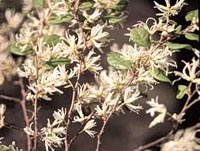Resource Library
Plant of the Week: Chinese Fringe Tree
The University of Arkansas System Division of Agriculture does not promote, support or recommend plants featured in "Plant of the Week." Please consult your local Extension office for plants suitable for your region.
Plant of the Week
Chinese Fringe Tree
Latin: Loropetalum chinense

The ice has melted and most of the power is back on, so now we can turn our attention
to an issue that will affect our landscapes as spring arrives – winter hardiness.
I’ve chosen Loropetalum for this discussion because it represents what gardeners
love to do, push the envelope on where plants will grow. Sometimes we get away with
it, sometimes we don’t.
Loropetalum is hardy in zones 7b or 8a, but even the experts aren’t sure just how
hardy the plant is because it’s only been widely planted in the Eastern landscape
for about 10 years. Since then, we’ve had mild winters and little challenge to its
northward creep.
The plant should be reliably hardy south of Little Rock, but areas north of there,
or with higher elevations, run some risk.
The business of guessing about plant hardiness began with a Harvard scientist named
Alfred Rehder. And let me assure you it is a guess, because many things are involved
in determining plant survival. Rehder had a long career working at Harvard’s Arnold
Arboretum. He devised a system in the late 1920s to predict where plants could be
grown in the U.S. His system was based on minimum winter temperature.
The 10 zones Rehder developed remained in place until 1962, when scientists at the
U.S. Department of Agriculture developed a better hardiness zone map based on the
better temperature data they had. The USDA zone map had 12 zones, and it gradually
replaced the Rehder map. It was updated about 1990 with a plethora of reporting stations
giving even better zonal gradation within states and counties.
As good as the map is, it’s still based on averages. Occasionally we have one of
those winters that help clarify our thinking about just where a plant can be safely
grown.
The ability of a plant to survive low winter temperatures relies on a plant cell’s
ability to protect itself from an ice crystal formation inside the cell. As winter
approaches, a plant cell exports water from the cell. It maintains a bare minimum
amount of so-called bound water inside the cell.
If thermocouples are placed in plant tissue and the temperature is slowly dropped,
scientists can tell when a plant cell is killed by freezing based on when the water
freezes. When water changes from the liquid state to the solid state, a burst of energy
is given off and thermocouples can measure this short-lived spike as an electrical
impulse.
As the temperature falls, the first water to freeze is the free water that is contained
between the cells, or in the vascular system of the plant. This gives off a large
spike of energy, called an exotherm, usually somewhere between 15 and 28 degrees.
This large, first exotherm is not the one that determines plant survival. It’s a second,
smaller event.
As the temperature drops lower and lower, eventually the water inside the cell freezes.
When this water freezes, the exotherm spike is smaller, but it signals the death of
the cell. The reason the water does not freeze at 32 degrees is because it’s in an
ultra-pure state and lacks an ice-nucleating agent for ice crystals to form on.
The temperature at which this second exotherm occurs marks the minimum temperature
that a plant will survive. For Loropetalum, this second exotherm probably occurs at
around 5 degrees. The absolute minimum temperature that any plant cell can forestall
this freezing is minus-40 degrees, which marks the boundary of the timberline on mountain
tops.
Different parts of a plant will tolerate different temperature extremes. Roots are
the least tolerant of freezing, followed by evergreen leaves, flowers, the phloem
tissue and, finally, the xylem. The top of a plant may freeze back, but the area close
to the ground may not sustain as cold a temperature as the exposed branch tips.
Gardeners will probably start observing signs of winter kill on many marginally hardy
shrubs as warm weather returns. The best approach is to take a wait-and-see attitude
and not be in a rush to prune. The extent of pruning needed can be easily determined
as March arrives.
By: Gerald Klingaman, retired
Extension Horticulturist - Ornamentals
Extension News - January 12, 2001
The University of Arkansas System Division of Agriculture does not maintain lists of retail outlets where these plants can be purchased. Please check your local nursery or other retail outlets to ask about the availability of these plants for your growing area.